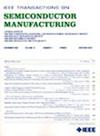MXenes作为控制ZnO薄膜p型电导率的工具
IF 2.3
3区 工程技术
Q2 ENGINEERING, ELECTRICAL & ELECTRONIC
引用次数: 0
摘要
本研究证明了通过加入不同摩尔浓度的MXenes, ZnO薄膜中p型和n型电导率的选择性调谐。采用高性价比的溶胶-凝胶法制备ZnO薄膜,并在450°C的高温和磁辅助条件下进行退火。通过热点探针的Rietveld分析和霍尔测量来证实MXene掺杂引起的电导率变化。结果表明,在280 G和400 G磁场下,n-ZnO的电导率从0.27 mho/cm显著增加到1274 mho/cm, p-ZnO的电导率分别从0.0012 mho/cm到6.2\ × 10^{-4}$ mho/cm和3.3\ × 10^{-3}$ mho/cm到0.84 mho/cm。XRD分析表明,该材料为多晶结构,平均晶粒尺寸约为~100 nm。这种新颖的方法提供了一种通用的方法来控制ZnO薄膜的导电性,包括对磁性的广泛分析。本文章由计算机程序翻译,如有差异,请以英文原文为准。
MXenes as a Tool to Control p-Type Conductivity in ZnO Thin Film
This study demonstrates the selective tuning of p-type and n-type conductivity in ZnO thin films by incorporating MXenes at varying molar concentrations. ZnO thin films were fabricated using a cost-effective sol-gel method and annealed at 450°C under thermal and magnetically assisted conditions. Rietveld analysis of the hot point probe and Hall measurements were performed to confirm the conductivity variations induced by MXene doping. The results suggest that the conductivity of n-ZnO increased significantly from 0.27 mho/cm to 1274 mho/cm, while p-ZnO conductivity ranged from 0.0012 mho/cm to $6.2\times 10^{-4}$ mho/cm and $3.3\times 10^{-3}$ mho/cm to 0.84 mho/cm under magnetic fields of 280 G and 400 G, respectively. XRD analysis revealed a polycrystalline structure with an average grain size of about ~100 nm. This novel approach offers a versatile method to control ZnO thin-film conductivity, including an extensive analysis of magnetic properties.
求助全文
通过发布文献求助,成功后即可免费获取论文全文。
去求助
来源期刊

IEEE Transactions on Semiconductor Manufacturing
工程技术-工程:电子与电气
CiteScore
5.20
自引率
11.10%
发文量
101
审稿时长
3.3 months
期刊介绍:
The IEEE Transactions on Semiconductor Manufacturing addresses the challenging problems of manufacturing complex microelectronic components, especially very large scale integrated circuits (VLSI). Manufacturing these products requires precision micropatterning, precise control of materials properties, ultraclean work environments, and complex interactions of chemical, physical, electrical and mechanical processes.
 求助内容:
求助内容: 应助结果提醒方式:
应助结果提醒方式:


